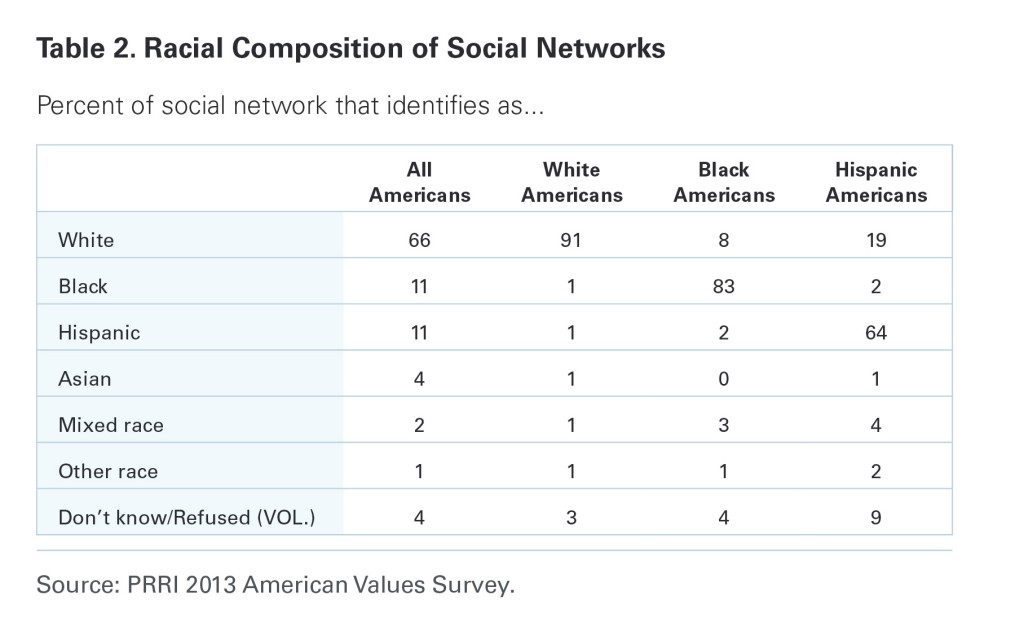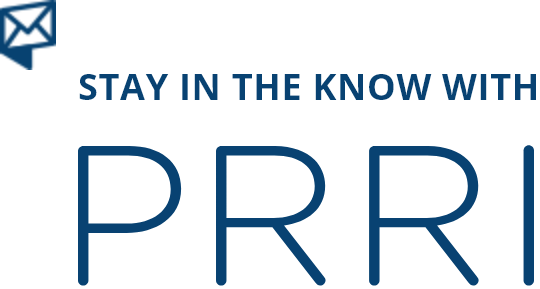Race and Americans’ Social Networks
In the 2013 American Values Survey (AVS), Public Religion Research Institute (PRRI) included a battery of questions designed to assess the scope and diversity of Americans’ social networks. Following an approach developed in the General Social Survey (GSS)*, respondents were asked to name up to seven people with whom they had “discussed important matters” in the past six months. Respondents were then asked to provide five attributes about each of those individuals, including gender, race and ethnicity, religious affiliation, 2012 vote preference, and relationship to the respondent. This approach—known in the social scientific literature as “egocentric network analysis”—is designed to measure the ways in which individuals’ choices and attitudes are influenced by their family and close friends.
Social Network Size and Distribution
There are only modest differences in the distribution and average size of Americans’ social networks. Among Americans overall, only eight percent name no persons in their social network, 50 percent name one to three persons, and 43 percent name four or more persons.
Americans overall reported, on average, a social network of 3.4 people out of a maximum of seven people. Overall, people named in these networks are slightly more likely to be immediate family members (an average of 1.8 people) than non-immediate family members (an average of 1.5 people).
Racial Composition of Social Networks
The degree of racial and ethnic diversity in Americans’ social networks varies significantly according to their particular race or ethnicity. Among white Americans, 91 percent of people comprising their social networks are also white, while five percent are identified as some other race. Among black Americans, 83 percent of people in their social networks are composed of people who are also black, while eight percent are white and six percent are some other race. Among Hispanic Americans, approximately two-thirds (64 percent) of the people who comprise their social networks are also Hispanic, while nearly 1-in-5 (19 percent) are white, and nine percent are some other race.
Racial Homogeneity of Social Networks
The homogeneity of a particular social network—that is, the percentage of Americans with social networks that are entirely comprised of people from the same racial or ethnic background—also varied according to race and ethnicity. Fully three-quarters (75 percent) of white Americans report that the network of people with whom they discuss important matters is entirely white, with no minority presence, while 15 percent report having a more racially mixed social network. Approximately two-thirds (65 percent) of black Americans report having a social network that is composed entirely of people who are also black, while nearly one-quarter (23 percent) say their network includes a mix of people from other racial and ethnic backgrounds. Less than half (46 percent) of Hispanics report that their social network includes only other people who also identify as Hispanic, while more than one-third (34 percent) report having a mixed social network. Notably, nearly one-in-ten (nine percent) Hispanics report having an all-white social network.
Racial Homogeneity of Whites’ Social Networks
There is little variation among white American subgroups in terms of the racial homogeneity of their social networks. White Republicans (81 percent) are no different from white Democrats (78 percent) in that they both have social networks that are entirely composed of whites. Among white independents, 73 percent say their social networks are comprised entirely of people who are white. More than 8-in-10 (82 percent) white Midwesterners report that their social networks are entirely composed of whites, compared to more than three-quarters of white Northeasterners (78 percent) and Southerners (77 percent), and 68 percent of white Westerners. White seniors (ages 65 and older) are only slightly more likely than white young adults (ages 18-29) to have entirely white social networks (80 percent vs. 72 percent). There are, however, no substantial differences by gender: men (76 percent) are about equally as likely as women (77 percent) to report having all-white social networks.
The 2013 American Values Survey covered a range of other topics, including analysis of libertarians in American politics. For additional findings from the 2013 American Values Survey, click here.
* Note that the PRRI survey design differs from the General Social Survey (GSS) in two ways. First, the survey was self-administered online. Second, the PRRI design allows respondents to name up to seven people comprising their social network instead of the GSS’s limit of five people.
Recommended citation:
Jones, Robert P., Daniel Cox, and Juhem Navarro-Rivera. “Race and Americans’ Social Networks.” PRRI. 2014. http://www.prri.org/research/analysis-social-network/.







